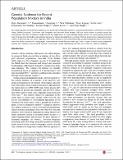| dc.contributor.author | Moorjani, Priya | |
| dc.contributor.author | Thangaraj, Kumarasamy | |
| dc.contributor.author | Patterson, Nick | |
| dc.contributor.author | Lipson, Mark | |
| dc.contributor.author | Loh, Po-Ru | |
| dc.contributor.author | Govindaraj, Periyasamy | |
| dc.contributor.author | Berger, Bonnie | |
| dc.contributor.author | Reich, David | |
| dc.contributor.author | Singh, Lalji | |
| dc.date.accessioned | 2014-12-19T19:48:19Z | |
| dc.date.available | 2014-12-19T19:48:19Z | |
| dc.date.issued | 2013-08 | |
| dc.date.submitted | 2013-05 | |
| dc.identifier.issn | 00029297 | |
| dc.identifier.issn | 1537-6605 | |
| dc.identifier.uri | http://hdl.handle.net/1721.1/92415 | |
| dc.description.abstract | Most Indian groups descend from a mixture of two genetically divergent populations: Ancestral North Indians (ANI) related to Central Asians, Middle Easterners, Caucasians, and Europeans; and Ancestral South Indians (ASI) not closely related to groups outside the subcontinent. The date of mixture is unknown but has implications for understanding Indian history. We report genome-wide data from 73 groups from the Indian subcontinent and analyze linkage disequilibrium to estimate ANI-ASI mixture dates ranging from about 1,900 to 4,200 years ago. In a subset of groups, 100% of the mixture is consistent with having occurred during this period. These results show that India experienced a demographic transformation several thousand years ago, from a region in which major population mixture was common to one in which mixture even between closely related groups became rare because of a shift to endogamy. | en_US |
| dc.description.sponsorship | National Science Foundation (U.S.). Graduate Research Fellowship | en_US |
| dc.language.iso | en_US | |
| dc.publisher | Elsevier | en_US |
| dc.relation.isversionof | http://dx.doi.org/10.1016/j.ajhg.2013.07.006 | en_US |
| dc.rights | Article is made available in accordance with the publisher's policy and may be subject to US copyright law. Please refer to the publisher's site for terms of use. | en_US |
| dc.source | Elsevier Open Archive | en_US |
| dc.title | Genetic Evidence for Recent Population Mixture in India | en_US |
| dc.type | Article | en_US |
| dc.identifier.citation | Moorjani, Priya, Kumarasamy Thangaraj, Nick Patterson, Mark Lipson, Po-Ru Loh, Periyasamy Govindaraj, Bonnie Berger, David Reich, and Lalji Singh. “Genetic Evidence for Recent Population Mixture in India.” The American Journal of Human Genetics 93, no. 3 (September 2013): 422–438. © 2013 The American Society of Human Genetics | en_US |
| dc.contributor.department | Massachusetts Institute of Technology. Computer Science and Artificial Intelligence Laboratory | en_US |
| dc.contributor.department | Massachusetts Institute of Technology. Department of Mathematics | en_US |
| dc.contributor.mitauthor | Lipson, Mark | en_US |
| dc.contributor.mitauthor | Loh, Po-Ru | en_US |
| dc.contributor.mitauthor | Berger, Bonnie | en_US |
| dc.relation.journal | The American Journal of Human Genetics | en_US |
| dc.eprint.version | Final published version | en_US |
| dc.type.uri | http://purl.org/eprint/type/JournalArticle | en_US |
| eprint.status | http://purl.org/eprint/status/PeerReviewed | en_US |
| dspace.orderedauthors | Moorjani, Priya; Thangaraj, Kumarasamy; Patterson, Nick; Lipson, Mark; Loh, Po-Ru; Govindaraj, Periyasamy; Berger, Bonnie; Reich, David; Singh, Lalji | en_US |
| dc.identifier.orcid | https://orcid.org/0000-0002-2724-7228 | |
| mit.license | PUBLISHER_POLICY | en_US |
| mit.metadata.status | Complete | |
